Flooding in Central Chile: Implications of Tides and Sea Level Increase in the 21st Century
Abstract
1. Introduction
2. Materials and Methods
2.1. Study Area
2.2. Methodology
2.2.1. Physical Characterization of the Lower Section of the Basin
2.2.2. Hydraulic Modeling and Sea Level
3. Results
3.1. Physical Characterization of the Lower Section
3.2. Tidal Inflow into the Estuary and River System
3.3. Tides and Floods
4. Discussion
5. Conclusions
Author Contributions
Funding
Acknowledgments
Conflicts of Interest
References
- Paprotny, D.; Sebastian, A.; Morales-Nápoles, O.; Jonkman, S. Trends in flood losses in Europe over the past 150 years. Nat. Commun. 2018, 9, 1985. [Google Scholar] [CrossRef] [PubMed]
- Yang, Z.; Wang, T.; Khangaonkar, T.; Breithaupt, S. Integrated modeling of flood flows and tidal hydrodynamics over a coastal floodplain. Environ. Fluid Mech. 2012, 12, 63–80. [Google Scholar] [CrossRef]
- Kulkarni, A.; Eldho, T.; Rao, E.; Mohan, B. An integrated flood inundation model for coastal urban watershed of Navi Mumbai, India. Nat. Hazards 2014, 73, 403–425. [Google Scholar] [CrossRef]
- Broekx, S.; Smets, S.; Liekens, I.; Bulckaen, D.; Nocker, L. Designing a long-term flood risk management plan for the Scheldt estuary using a risk-based approach. Nat. Hazards 2011, 57, 245–266. [Google Scholar] [CrossRef]
- Garcia, E.; Loáiciga, H. Sea-level rise and flooding in coastal riverine flood plains. Hydrol. Sci. J. 2014, 59, 204–220. [Google Scholar] [CrossRef]
- Mah, D.; Putuhena, F.; Lai, S. Modelling the flood vulnerability of deltaic Kuching City, Malaysia. Nat. Hazards 2011, 58, 865–875. [Google Scholar] [CrossRef]
- Dilley, M.; Chen, R.; Deichmann, U.; Lorner-Lam, A.; Arnold, M. Natural Disaster Hotspots A Global Risk; The World Bank: Washington, DC, USA, 2005. [Google Scholar]
- Eliot, M. Sea level variability influencing coastal flooding in the Swan River region, Western Australia. Cont. Shelf Res. 2012, 33, 14–28. [Google Scholar] [CrossRef]
- Yan, Y.; Ouyang, Z.; Guo, H.; Jin, S.; Zhao, B. Detecting the spatiotemporal changes of tidal flood in the estuarine wetland by using MODIS time series data. J. Hydrol. 2010, 384, 156–163. [Google Scholar] [CrossRef]
- Burrel, B.C.; Davar, K.; Hughes, R. A Review of Flood Management Considering the Impacts of Climate Change. Water Int. 2007, 32, 342–359. [Google Scholar] [CrossRef]
- Gallien, T.W.; Schubert, J.E.; Sanders, B.F. Predicting tidal flooding of urbanized embayments: A modeling framework and data requirements. Coast. Eng. 2011, 58, 567–577. [Google Scholar] [CrossRef]
- Salman, A.M.; Li, Y. Flood Risk Assessment, Future Trend Modeling, and Risk Communication: A Review of Ongoing Research. Nat. Hazards Rev. 2018, 19, 04018011. [Google Scholar] [CrossRef]
- Rojas, O.; Mardones, M.; Arumí, J.; Aguayo, M. Una revisión de inundaciones fluviales en Chile, período 1574–2012: Causas, recurrencia y efectos geográficos. Rev. Geogr. Norte Gd. 2014, 57, 177–192. [Google Scholar] [CrossRef]
- Rojas, O.; Mardones, M.; Rojas, C.; Martínez, C.; Flores, L. Urban Growth and Flood Disasters in the Coastal River Basin of South-Central Chile (1943–2011). Sustainability 2017, 9, 195. [Google Scholar] [CrossRef]
- Yin, J.; Yin, Z.; Hu, X.; Xu, S.; Wang, J.; Li, Z.; Zhong, H.; Gan, F. Multiple scenario analyses forecasting the confounding impacts of sea level rise and tides from storm induced coastal flooding in the city of Shanghai, China. Environ. Earth Sci. 2011, 63, 407–414. [Google Scholar] [CrossRef]
- Morales, J.; Delgado, I.; Gutierrez-Mas, J. Sedimentary characterization of bed types along the Guadiana estuary (SW Europe) before the construction of the Alqueva dam. Estuar. Coast. Shelf Sci. 2006, 70, 117–131. [Google Scholar] [CrossRef]
- Jakobsen, F.; Hoque, A. Evaluation of the short-term processes forcing the monsoon river floods in Bangladesh. Water Int. 2005, 30, 389–399. [Google Scholar] [CrossRef]
- Vanney, J. L’Hydrologie Du Bas Guadalquivir; Consejo Superior de Investigaciones Científicas: Madrid, Spain, 1970. [Google Scholar]
- Yin, J.; Yu, D.; Yin, Z.; Wang, J.; Xu, S. Modelling the combined impacts of sea-level rise and land subsidence on storm tides induced flooding of the Huangpu River in Shanghai, China. Clim. Chang. 2013, 119, 919–932. [Google Scholar] [CrossRef]
- Rojas, C.; Mardones, M. Las Inundaciones en la ciudad de Valdivia. Eventos Históricos 1899–2002. Rev. Geogr. Valpso. 2003, 34, 225–242. [Google Scholar]
- Paprotny, D.; Terefenko, P. New estimates of potential impacts of sea level rise and coastal floods in Poland. Nat. Hazards 2017, 85, 1249–1277. [Google Scholar] [CrossRef]
- Chust, G.; Caballero, A.; Marcos, M. Regional scenarios of sea level rise and impacts on Basque (Bay of Biscay) coastal habitats, throughout the 21st century. Estuar. Coast. Shelf Sci. 2010, 87, 113–124. [Google Scholar] [CrossRef]
- IPCC. Climate Change 2013: The Physical Science Basis. Contribution of Working Group I to the Fifth Assessment Report of the Intergovernmental Panel on Climate Change; Stocker, T.F., Qin, D., Plattner, G.-K., Tignor, M., Allen, S.K., Boschung, J., Nauels, A., Xia, Y., Bex, V., Midgley, P.M., Eds.; Cambridge University Press: Cambridge, UK; New York, NY, USA, 2013. [Google Scholar] [CrossRef]
- Contreras, M.; Winckler, G.; Molina, M. Implicancias de la Variación del Nivel Medio del Mar Por Cambio Climático en Obras de Ingeniería Costera de Chile. In Anales del Instituto de Ingenieros; Instituto de Ingenieros de Chile: Santiago, Chile, 2012; Volume 124, pp. 54–66. [Google Scholar]
- Comisión Permanente del Pacífico Sur CPPS-PNUMA. Evaluación de la Vulnerabilidad de las Areas Costeras a Incrementos en el Nivel del mar como Consecuencia del Calentamiento Global: Caso de Estudio-Bahía de Concepción, Chile; Comisión Permanente del Pacífico Sur (CPPS) Programa de las Naciones Unidas para el Medio Ambiente (PNUMA): Santiago, Chile, 1997. [Google Scholar]
- Kundzewicz, Z.W.; Schellnhuber, H. Floods in the IPCC TAR perspective. Nat. Hazards 2004, 31, 111–128. [Google Scholar] [CrossRef]
- Peña, H.; Klohn, W. Hidrología de desastres en Chile; crecidas catastróficas recientes de origen no meteorológico. Rev. Soc. Chil. Ingener. Hidraúl. 1990, 5, 21–38. [Google Scholar]
- Instituto Nacional de Estadística (INE). Censo de Población y Vivienda; INE: Santiago, Chile, 2002. [Google Scholar]
- Vidal, C.; Aravena, H.R. Efectos ambientales de la urbanización de las cuencas de los ríos Bíobío y Andalién sobre los riesgos de inundación y anegamiento de la ciudad de Concepción. In Concepción Metropolitano (AMC). Planes, Procesos y Proyectos; Pérez, L., Hidalgo, R., Eds.; Pontificia Universidad Católica de Chile: Santiago, Chile, 2010. [Google Scholar]
- Mardones, M.; Echeverría, F.; Jara, C. Una contribución al estudio de los desastres naturales en Chile Centro Sur: Efectos ambientales de las precipitaciones del 26 de junio del 2005 en el área Metropolitana de Concepción. Investig. Geogr. Chile 2004, 38, 1–25. [Google Scholar] [CrossRef]
- Pulido, H. Estudio Hidrológico Forestal de la Cuenca del Río Andalién. Bachelor’s Thesis, Universidad de Concepción, Concepción, Chile, 1992. [Google Scholar]
- Hernández, T. Caracterización Hidrológica y Geomorfológica del Río Andalién. Bachelor’s Thesis, Universidad de Concepción, Concepción, Chile, 1999. [Google Scholar]
- Mendoza, F. Desarrollo de un Modelo de Pronóstico de Crecidas Para la Cuenca del Río Andalien. Bachelor’s Thesis, Universidad de Concepción, Concepción, Chile, 2004. [Google Scholar]
- Inostroza, A. Crecidas en la Andalién bajo: Análisis hidráulico de las Intervenciones en su Planicie de Inundación. Bachelor’s Thesis, Universidad de Concepción, Concepción, Chile, 2005. [Google Scholar]
- Bravo, I. Efectos de la Precipitación Antecedente Sobre la Respuesta Hidrológica del Río Andalién. Bachelor’s Thesis, Universidad de Concepción, Concepción, Chile, 2005. [Google Scholar]
- Muñoz, M. Análisis de Crecidas a Través de Balance Hídrico: Aplicación al Río Andalién Mediante Embalse Linea. Bachelor’s Thesis, Universidad del Bío-Bío, Concepción, Chile, 2007. [Google Scholar]
- Kadam, P.; Sen, D. Flood inundation simulation in Ajoy River using MIKE-FLOOD. ISH J. Hydraul. Eng. 2012, 18, 37–41. [Google Scholar] [CrossRef]
- Yáñez-Arancibia, A.; Day, J.; Reyes, E. Understanding the Coastal Ecosystem-Based Management Approach in the Gulf of Mexico. J. Coast. Res. 2013, 63, 243–261. [Google Scholar] [CrossRef]
- De Figueiredo, S. Modeling climate change effects in southern Brazil. J. Coast. Res. 2013, 65, 1933–1938. [Google Scholar] [CrossRef]
- Jaque, E. Análisis Integrado de los Sistemas Naturales del río Andalién. Ph.D. Thesis, Universidad de Concepcion, Concepcion, Chile, 1996. [Google Scholar]
- Jaque, E. Diagnóstico de los paisajes Mediterráneos Costeros. Cuenca del río Andalién, Chile. Bol. Asoc. Geógr. Esp. 2010, 54, 81–97. [Google Scholar]
- Devynck, J. Contribución al Conocimiento de la Circulación Atmosférica en Chile y al Clima de la Región del Biobío; Universidad de Concepción: Concepción, Chile, 1970. [Google Scholar]
- Peña, F.; Taveres, C.; Mardones, M. Las condiciones climáticas como factor de riesgo en la comuna de Talcahuano. Rev. Geogr. Chile Terra Aust. 1993, 38, 83–107. [Google Scholar]
- Arrau Ingeniería. Estudio de Factibilidad y Diseño Definitivo de las Obras de Regulación y Retención de Sedimentos en Río Andalién, Región del Bío–Bío; Dirección de Obras Hidráulicas Gobierno de Chile: Santiago, Chile, 2012. [Google Scholar]
- Prisma Ingeniería Limitada. Diagnóstico y Proposición de Soluciones Rio Andalién; Comuna de Concepción, VIII Region. M.O.P.-D.O.H; Gobierno de Chile: Santiago, Chile, 2004. [Google Scholar]
- Perillo, G.; Piccolo, M. Methodology to study estuarine cross-sections. Rev. Geofís. 1993, 38, 189–206. [Google Scholar]
- Madden, C.; Goodin, K.; Allee, R.; Bamford, D.; Finkbeiner, D. Clasificación Ecológica Estandarizada Costera y Marina- Versión III: La Clasificación de Referencia Para Hábitats Marinos Para la Red Temática de Ecosistemas IABIN; Nature Serve: Arlington, VA, USA, 2008. [Google Scholar]
- Wentworth, C.K. A scale of grade & class terms for clastic sediments. J. Geol. 1922, 30, 377–392. [Google Scholar]
- Folk, R.; Andrews, P.; Lewis, D. Detrital sedimentary rock classification & nomenclature for use in New Zeland. New Zeland. J. Geol. Geophys. 1970, 13, 937–968. [Google Scholar]
- Blott, S.; Pye, K. GRADISTAT: A grain size distribution and statistics package for the analysis of unconsolidated sediments. Earth Surf. Proc. Land. 2001, 26, 1237–1248. [Google Scholar] [CrossRef]
- Davies, J.L. A morphogenetic approach to Word shorelines. Z. Geomorphol. 1964, 8, 127–142. [Google Scholar]
- Haralambidou, K.; Sylaios, G.; Tsihrintzis, V.A. Salt-wedge propagation in a Mediterranean micro-tidal river mouth. Estuar. Coast. Shelf Sci. 2010, 90, 174–184. [Google Scholar] [CrossRef]
- Rojas, O. Cambios Ambientales y Dinámica de Inundaciones Fluviales en una Cuenca Costera del Centro sur de Chile. Ph.D. Thesis, Universidad de Concepción, Concepción, Chile, 2015. [Google Scholar]
- Brunner, G.W. HEC-RAS, River Analysis System Hydraulic Reference Manual; US Army Corps of Engineers Hydrologic Engineering Center: Davis, CA, USA, 2010. [Google Scholar]
- Kopp, R.; Horton, R.; Little, C.; Mitrovica, J.; Oppenheimer, M.; Rasmussen, D.; Strauss, B.; Tebaldi, C. Probabilistic 21st and 22nd century sea-level projections at a global network of tide-gauge sites. Earths Future 2014, 2, 383–407. [Google Scholar] [CrossRef]
- Environmental Systems Research Institute (ESRI). ArcGIS 9.3; ESRI: Redlands, CA, USA, 2009. [Google Scholar]
- Barnes, H. Roughness Characteristics of Natural Channels; USGS: Washington, DC, USA, 1967. [Google Scholar]
- Garcés-Vargas, J.; Ruiz, M.; Pardo, L.M.; Nuñez, S.; Pérez-Santos, I. Caracterización hidrográfica del estuario del río Valdivia, centro-sur de Chile. Lat. Am. J. Aquat. Res. 2013, 41, 113–125. [Google Scholar] [CrossRef]
- Morales, J.A.; Pons, J.M.; Catano, M. Introducción al análisis de los riesgos de inundación en las riberas de las áreas estuarinas: El caso de las poblaciones adyacentes a la Ría de Huelva (SO España). Geogaceta 2005, 37, 243–246. [Google Scholar]
- Flick, R.E. Comparison of California tides, storm surges, and mean sea level during the El Niño winters of 1982–1983 and 1997–1998. Shore Beach. 1998, 66, 7–11. [Google Scholar]
- Benz, H.M.; Herman, M.; Tarr, A.C.; Hayes, G.P.; Furlong, K.P.; Villaseñor, A.; Dart, R.L.; Rhea, S. Seismicity of the Earth 1900–2010 Australia Plate and Vicinity; U.S. Geological Survey Open-File Report 2010–1083-G, scale 1:15,000,000; U.S. Geological Survey: Reston, VA, USA, 2011.
- Di Leo, J.F.; Wookey, J.; Hammond, J.; Kendall, J.; Kaneshima, S.; Inoue, H.; Yamashina, T.; Harjadi, P. Mantle flow in regions of complex tectonics: Insights from Indonesia. Geochem. Geophys. 2012, 13, Q12008. [Google Scholar] [CrossRef]
- López-Fernández, C.; Pulgar, J.A.; Gallar, J.; González-Cortina, J.M.; Díaz, J.; Ruíz, M. Zonación sismotectónica del NO de la Península Ibérica. Geo-Temas 2008, 10, 1031–1034. [Google Scholar]
- Molina, M.; Contreras, M.; Winckler, G.; Salinas, S.; Reyes, M. Consideraciones Sobre las Variaciones de Mediano y Largo Plazo del Oleaje en el Diseño de Obras Marítimas en Chile Central; Anales del Instituto de Ingenieros de Chile: Santiago, Chile 2011; Volume 123. [Google Scholar]
- Isla, F.; Quezada, J.; Martínez, C.; Fernández, A.; Jaque, E. The evolution of the Bío Bío delta & the coastal plains of the Arauco Gulf, Bío Bío Region: The Holocene sea-level curve of Chile. J. Coast. Res. 2012, 28, 102–111. [Google Scholar]
- Albrecht, F. Personal communication. 2015. [Google Scholar]
- Kaizuka, S.; Matsuda, T.; Nogami, M.; Yonekura, N. Quaternary Tectonic and Recent Seismic Crustal Movements in the Arauco Peninsula and Its Environs, Central Chile; Geographical Reports of Tokyo Metropolitan University: Tokyo, Japón, 1973. [Google Scholar]
- Vargas, G.; Farías, M.; Carretier, S.; Tassara, A.; Baize, S.; Melnick, D. Coastal uplift and tsunami effects associated to the 2010 Mw8.8 Maule earthquake in Central Chile. Andean Geol. 2011, 38, 219–238. [Google Scholar]
- Rivas, L. Red Geodésica Nacional SIRGAS—Chile; Departamento Geodésico Instituto Geográfico Militar Chile (Presentación): Santiago, Chile, 2012. [Google Scholar]
- Pulido, N.; Yagi, Y.; Kumagai, H.; Nishimura, N. Rupture process and coseismic deformations of the 27 February 2010 Maule Earthquake, Chile. Earth Planets Space 2011, 63, 955–959. [Google Scholar] [CrossRef]
- Quezada, J.; Jaque, E.; Belmonte, A.; Fernández, A.; Vásquez, D.; Martínez, C. Movimientos cosísmicos verticales y cambios geomorfológicos generados durante el terremoto Mw = 8,8 del 27 de febrero de 2010 en el centro—Sur de Chile. Rev. Geogr. Sur. 2010, 2, 11–45. [Google Scholar]
- Martínez, C.; Rojas, O.; Aránguiz, R.; Belmonte, A.; Altamirano, A.; Flores, P. Riesgo de tsunami en caleta Tubul, Región del Biobío: Escenarios extremos y transformaciones territoriales posterremoto. Rev. Geogr. Norte Gd. 2012, 53, 85–106. [Google Scholar] [CrossRef]
- Rojas, C.; Munizaga, J.; Rojas, O.; Martínez, C.; Pino, J. Land Use Policy Urban development versus wetland loss in a coastal Latin American city: Lessons for sustainable land use planning. Land Use Policy 2019, 80, 47–56. [Google Scholar] [CrossRef]
- Broekx, S.; Smets, S.; Liekens, I.; Bulckaen, D.; Nocker, L. De Designing a long-term flood risk management plan for the Scheldt estuary using a risk-based approach. Nat. Hazards 2011, 57, 245–266. [Google Scholar] [CrossRef]
- Masood, M.; Takeuchi, K. Assessment of flood hazard, vulnerability and risk of mid-eastern Dhaka using DEM and 1D hydrodynamic model. Nat. Hazards 2012, 61, 757–770. [Google Scholar] [CrossRef]
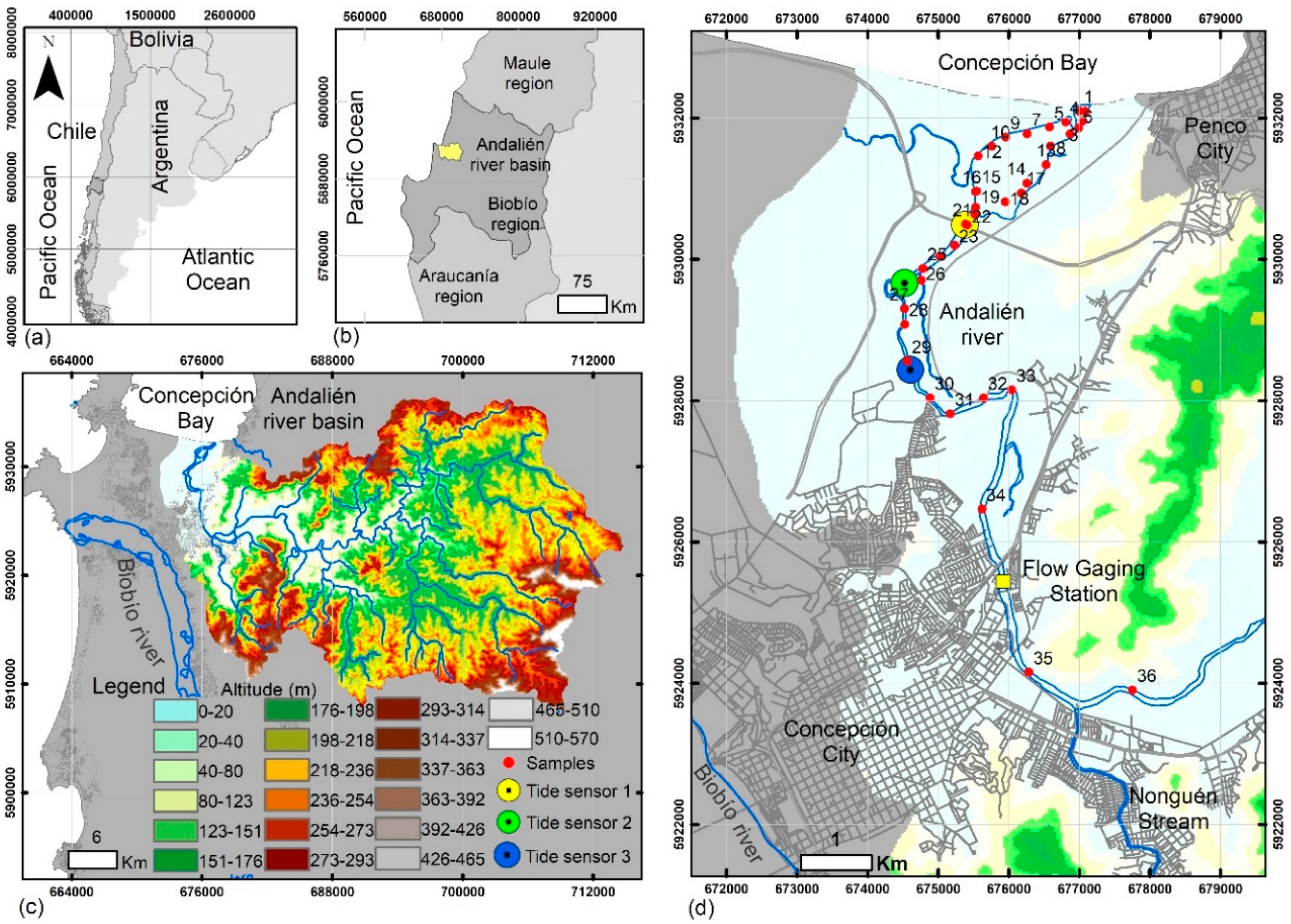
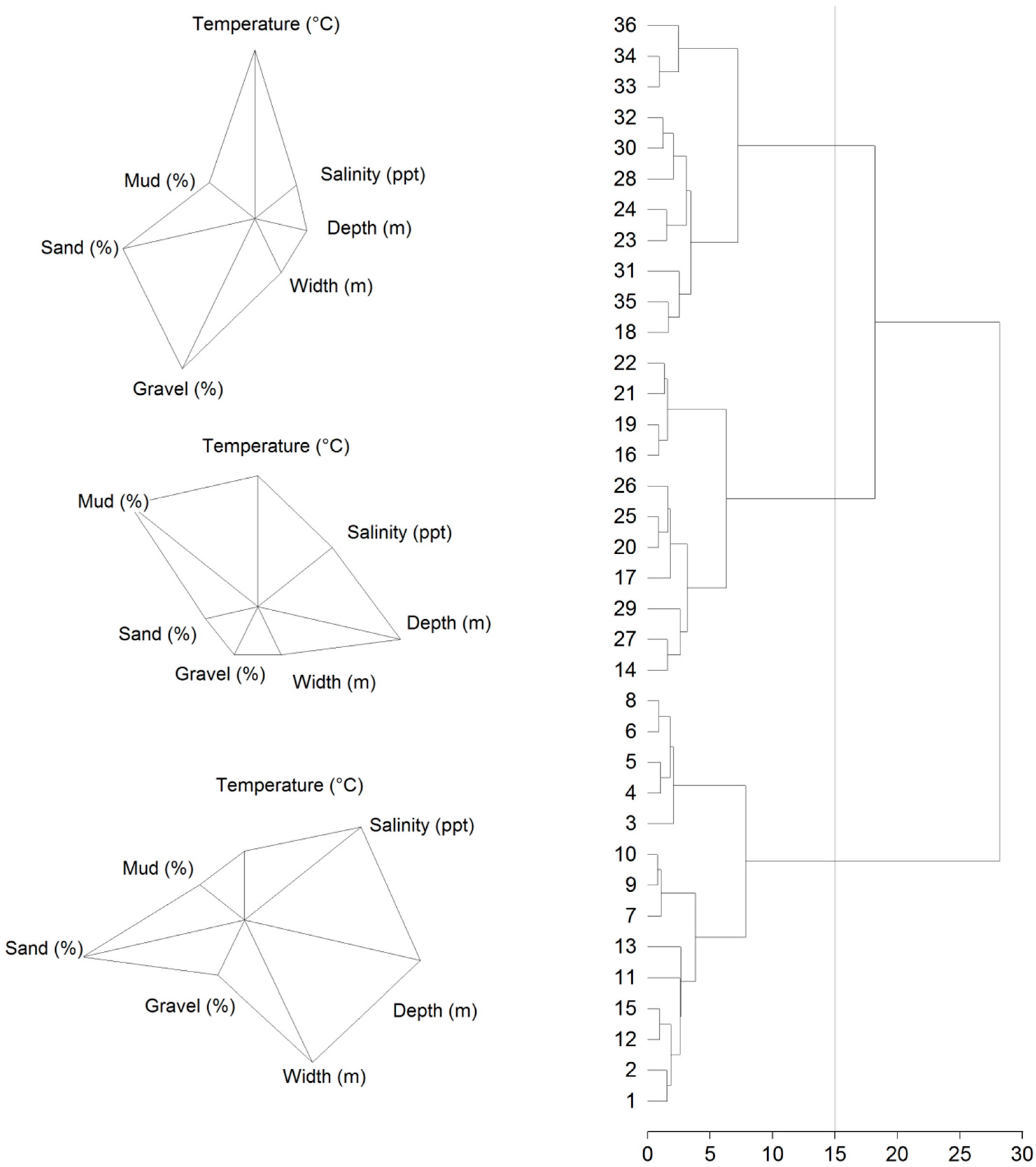
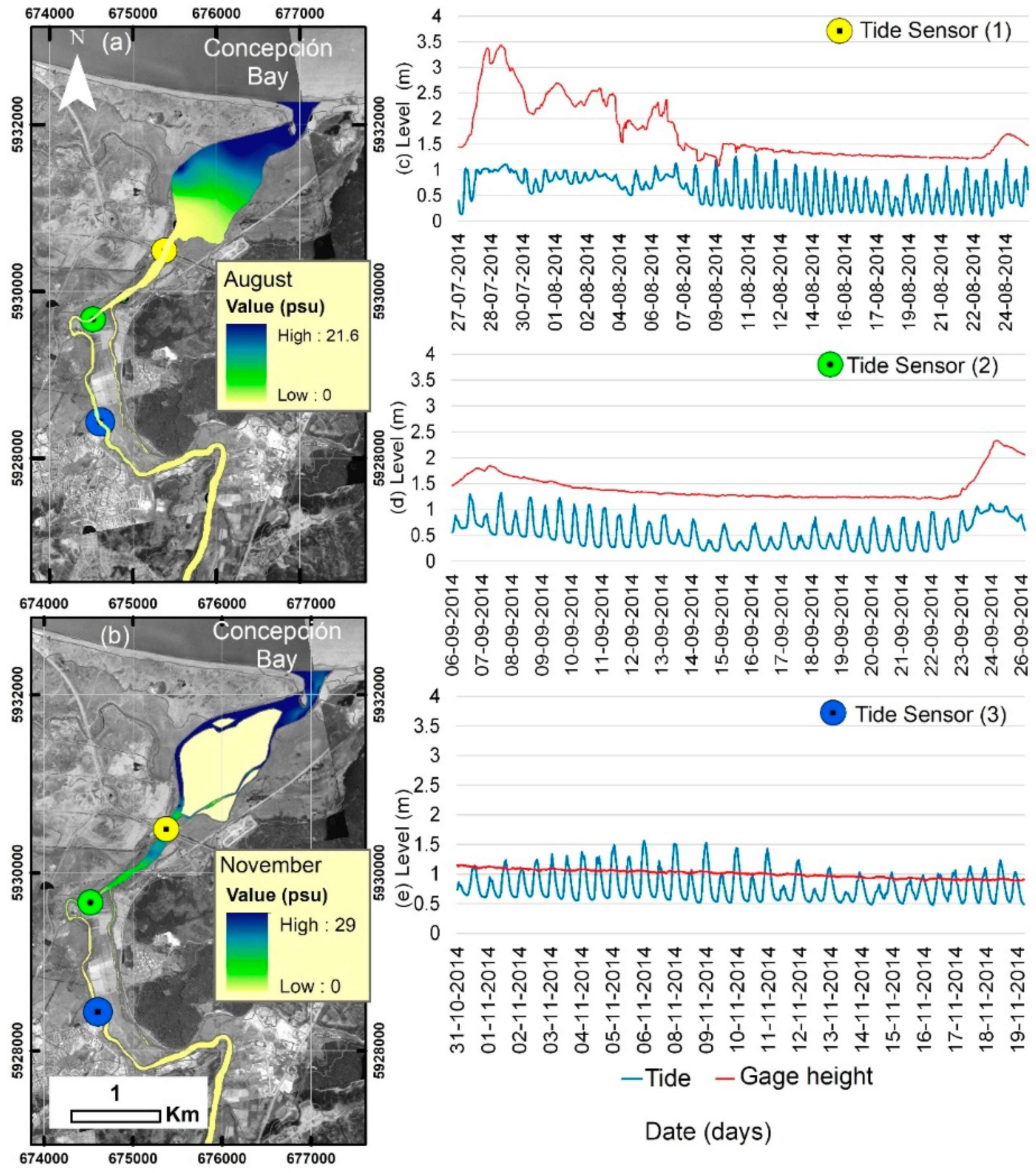
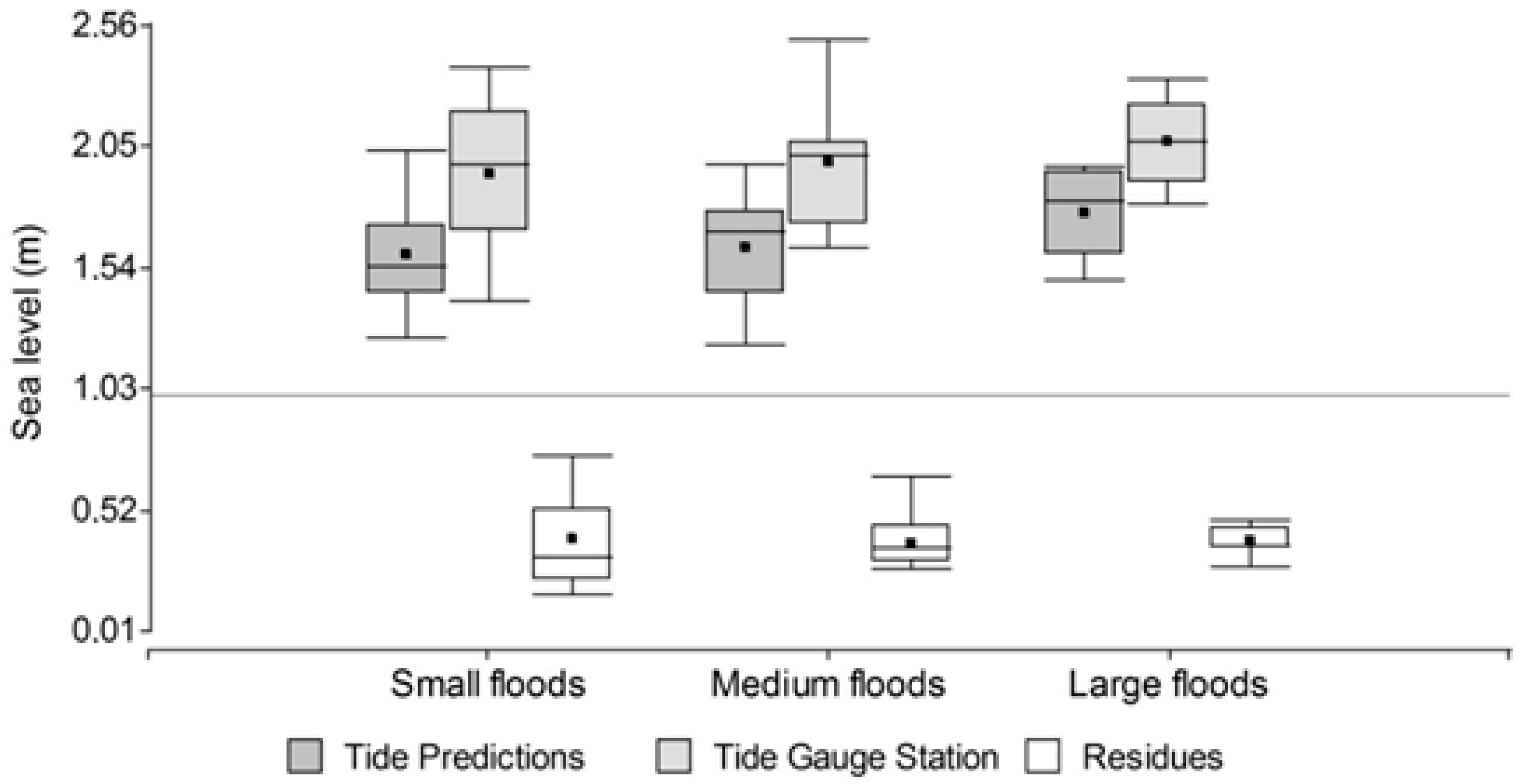
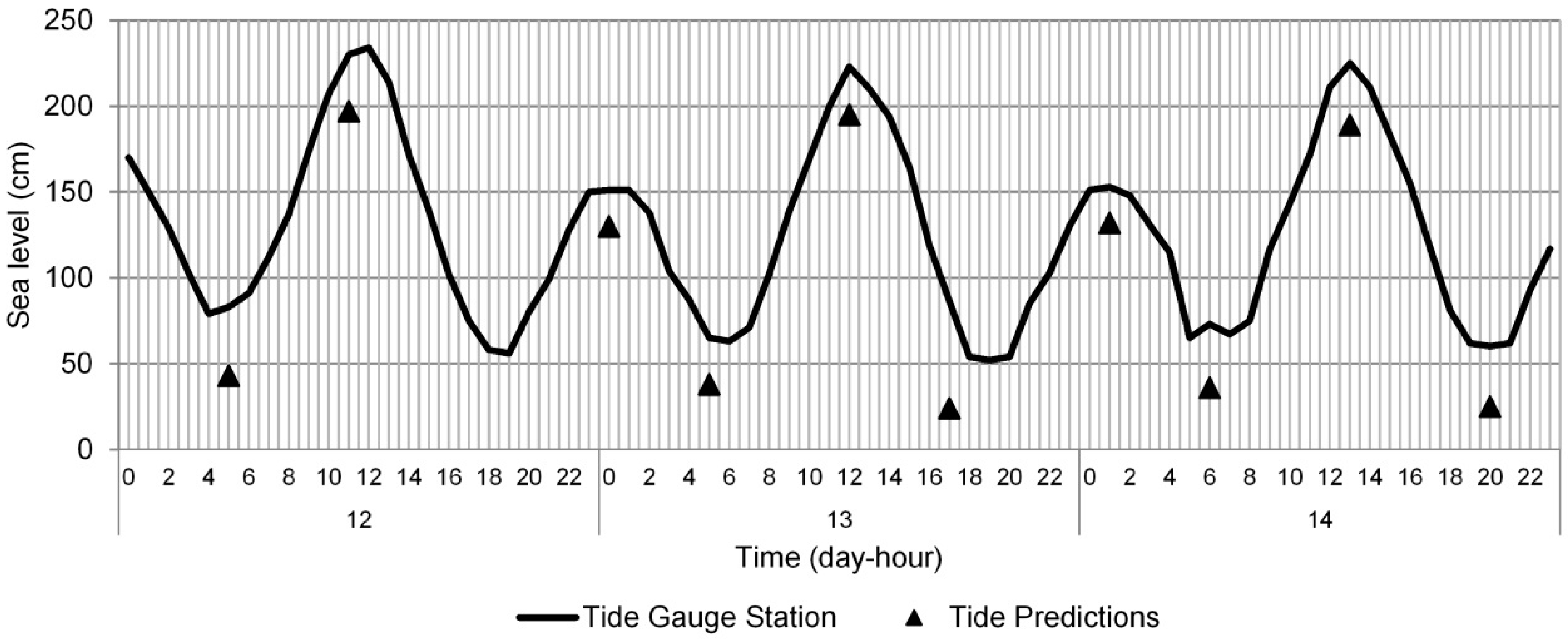
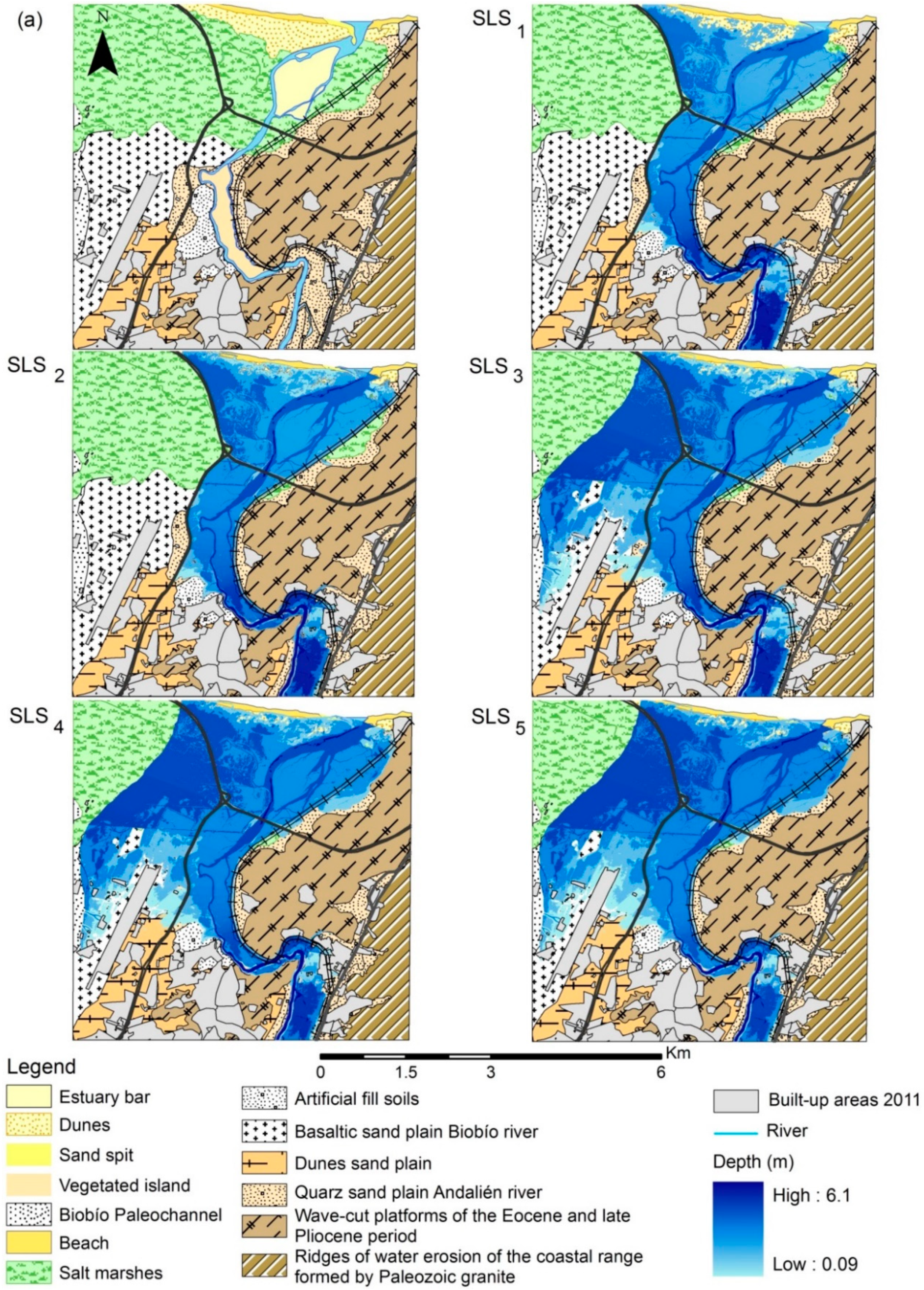
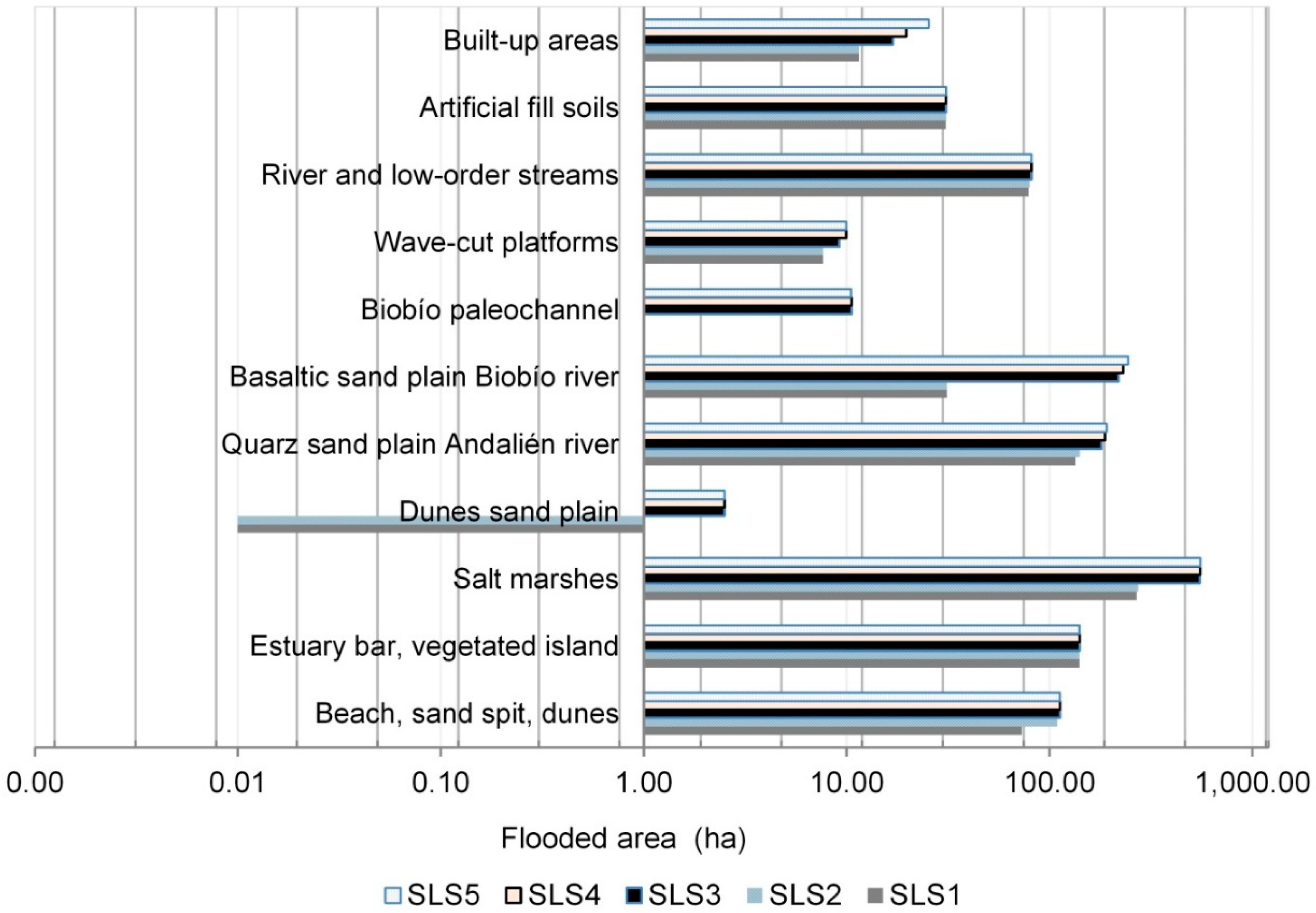

| Peak Flow (m3/s) | Astronomical Tide | Meteorological Tide | ||||
|---|---|---|---|---|---|---|
| SLS1_D100 | 634 | 0.50 | 0.50 | - | 0.50 | |
| SLS2_D100 | 634 | 1.97 | 1.97 | - | 1.97 | |
| SLS3_D100 | 634 | 1.97 | 0.37 | 2.34 | - | 2.34 |
| SLS4_D100 | 634 | 1.97 | 0.37 | 2.34 | 0.30 | 2.64 |
| SLS5_D100 | 634 | 1.97 | 0.37 | 2.34 | 0.60 | 2.94 |
| Cluster 1 | Cluster 2 | Cluster 3 | p Value | |
|---|---|---|---|---|
| Temp. (°C) | 14.91 (1.17) c | 19.70 (2.45) b | 22.61 (2.34) a | <0.0001 |
| Salinity (psu) * | 23.63 (4.41) a | 11.55 (8.09) b | 2.25 (4.22) c | <0.0001 |
| Depth. (m) | 1.22 (0.23) a | 1.06 (0.16) a | 0.70 (0.26) b | <0.0001 |
| Width (m) | 157.20 (109.02) a | 61.64 (30.59) b | 68.18 (47.32) b | 0.0019 |
| Gravel (%) | 2.69 (3.45) b | 1.92 (6.36) b | 16.91 (15.35) a | 0.0007 |
| Sand (%) | 85.42 (11.66) a | 31.76 (18.04) c | 69.98 (13.17) b | <0.0001 |
| Mud (%) | 11.88 (9.83) b | 66.27 (18.31) a | 13.11 (13.20) b | <0.0001 |
| Value | Sensor 1 * | Sensor 2 ** | Sensor 3 *** |
|---|---|---|---|
| Average | 0.55 | 0.55 | 0.80 |
| Maximum | 1.53 | 1.32 | 1.57 |
| Minimum | 0.08 | 0.17 | 0.48 |
| Amplitude | 1.45 | 0.81 | 0.94 |
© 2018 by the authors. Licensee MDPI, Basel, Switzerland. This article is an open access article distributed under the terms and conditions of the Creative Commons Attribution (CC BY) license (http://creativecommons.org/licenses/by/4.0/).
Share and Cite
Rojas, O.; Mardones, M.; Martínez, C.; Flores, L.; Sáez, K.; Araneda, A. Flooding in Central Chile: Implications of Tides and Sea Level Increase in the 21st Century. Sustainability 2018, 10, 4335. https://doi.org/10.3390/su10124335
Rojas O, Mardones M, Martínez C, Flores L, Sáez K, Araneda A. Flooding in Central Chile: Implications of Tides and Sea Level Increase in the 21st Century. Sustainability. 2018; 10(12):4335. https://doi.org/10.3390/su10124335
Chicago/Turabian StyleRojas, Octavio, María Mardones, Carolina Martínez, Luis Flores, Katia Sáez, and Alberto Araneda. 2018. "Flooding in Central Chile: Implications of Tides and Sea Level Increase in the 21st Century" Sustainability 10, no. 12: 4335. https://doi.org/10.3390/su10124335
APA StyleRojas, O., Mardones, M., Martínez, C., Flores, L., Sáez, K., & Araneda, A. (2018). Flooding in Central Chile: Implications of Tides and Sea Level Increase in the 21st Century. Sustainability, 10(12), 4335. https://doi.org/10.3390/su10124335





